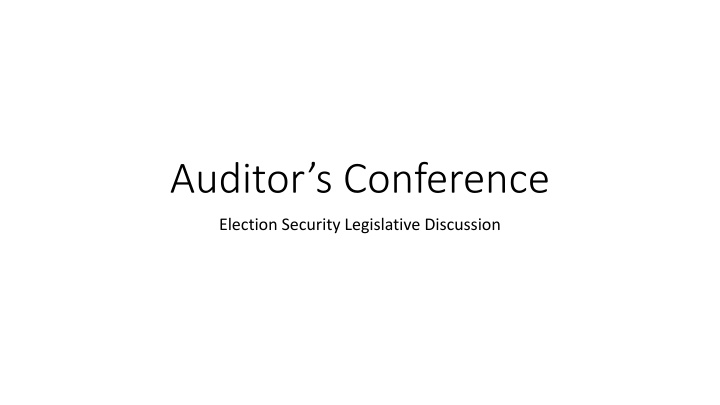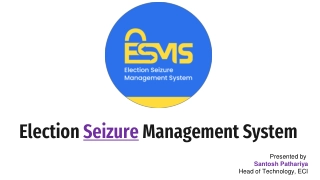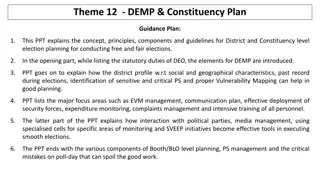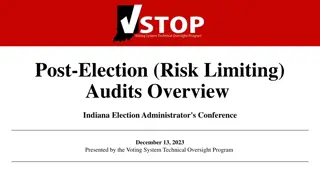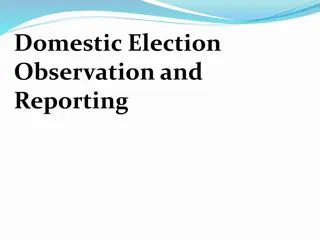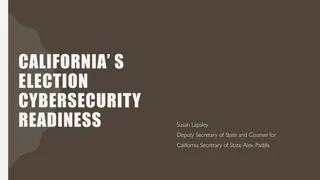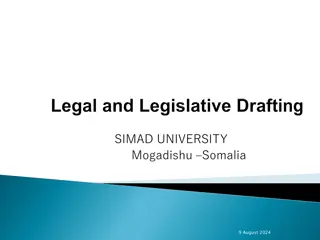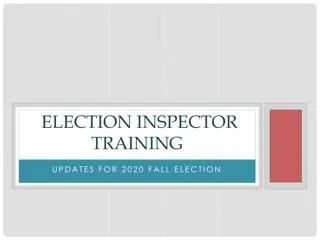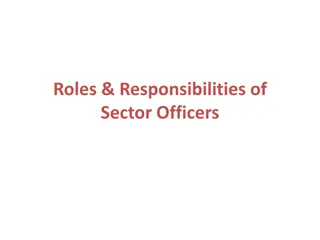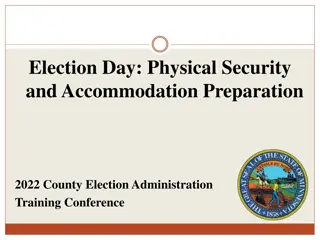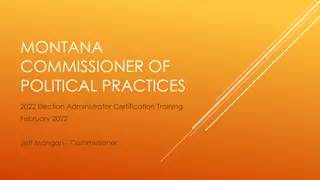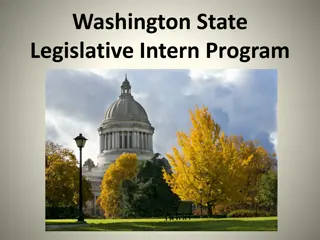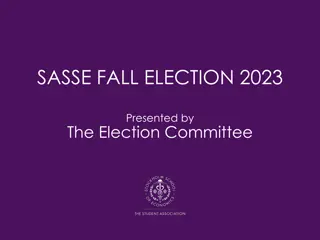Enhancing Election Security and Legislative Processes
Explore the various aspects of improving election security and legislative processes, including enhancing signature witnessing, reorganizing post-election audits, updating recount procedures, and considering modernizing methods such as Risk Limiting Audits (RLA). The focus is on ensuring transparency, accuracy, and efficiency in the electoral system.
Download Presentation

Please find below an Image/Link to download the presentation.
The content on the website is provided AS IS for your information and personal use only. It may not be sold, licensed, or shared on other websites without obtaining consent from the author.If you encounter any issues during the download, it is possible that the publisher has removed the file from their server.
You are allowed to download the files provided on this website for personal or commercial use, subject to the condition that they are used lawfully. All files are the property of their respective owners.
The content on the website is provided AS IS for your information and personal use only. It may not be sold, licensed, or shared on other websites without obtaining consent from the author.
E N D
Presentation Transcript
Auditors Conference Election Security Legislative Discussion
Last years bill 2647/6412 had several parts Improve signature witness information Reorganize and improve post-election audits Update the recount process Protect the ballot collection process Remove electronic ballot return
Witnessing Signatures The process for signature witnessing needs to be improved We have new WAC language that makes it clearer that a person is unable to sign if they are physically present with the ballot but cannot sign. The bill would gather a phone number or email address for each witness The bill places the requirement in statute, so all counties will do it the same Ballot return envelopes Ballot curing forms
Reorganize and improve post-election audits Primarily cleanup from the bill passed in 2018. This is a reorganization of EXISTING POLICY Requirements unpacked to be more easily understood and explained. Standalone sections: DRE audits Duplicated ballot audits The three choices for post-election audit Random check of ballot counting equipment RLA for older systems RLA for digital scan systems.
Options for RLA At some point in the future Risk Limiting Audits will become standard practice. The League of Women Voters and the legislature are very motivated. At this point, there is room for us as a community to learn and perfect before it is put into statute. The League made several suggestions to improve the language in statute, we intend to include those suggestions again. They involve definitions and labels for the process. The LWV also wants a large increase in reported information they refer to these as audit reports . See the handout for the detail. processes
Update the recount process Recounts are intended to confirm close counts and give the public assurance of the results. This is the section that has the most opportunity for design improvement. The last update to recount processes was done in 2005, the systems have changed a great deal since then. Risk-limiting audits are an important new tool and should be part of the recount process
Possible Improvements Intent: Modernize and update the process Today s systems are much more accurate Explore options to merge the RLA process with the recount process Acknowledge that the machine recount doesn t really prove anything or provide observers with a sense that the results have been double checked. We could make all recounts hand recounts and adjust the threshold to .33% We could create a merge of RLA from .5% to .25% and hand count below .25% We could remove machine recounts and maintain the current .25% with an additional requirement to recount races closer than 10 votes. Remove PCOs from statute?
Data review I took data Pierce created, added the most recent and found this: There were 134 recounts between from 2007 to 2019 inclusive. Out of the 134 there were two with a changed outcome 2009 OpScan one vote separated out of 1,900. Hand count, losing candidate gained 3. 2015 three votes out of 12,350 Hand count, losing candidate gained three and won flip. There were 59 where vote totals changed but not the outcome Almost all had a change of one vote, and with the following exceptions less than four 2008 OpScan Hand 84 votes gained, margin increase from 118 to 134 out of 68,756 2011 OpScan Hand 22 votes gained margin increase from 12 to 20 out of 7,200 2015 OpScan Hand 6 votes gained margin increased from 19 to 21 out to 5,500 2016 OpScan Hand 6 votes gained margin increased from 11 to 13 out of 4,450 This OpScan system has been replaced.
Data review In the last two years, accuracy of the systems has been in the 1/1000th of a percent (.001%) to 2.38/100ths of a percent (.0238%). Comparing .001% or even .0238% to .5% or .25%. A narrower recount trigger of .25% is still more than 10 times the greatest error rate. Including a less than 10 votes margin makes it so a needed recount would never be missed.
The Way Forward Likelihood of an error of greater than 10 votes is extremely low 10 votes is more than any change in recounts since 2012 and all recounts using Digital Scan systems. Because of improved reconciliation reporting, there is little reason to recount .5% margins (except if the margin is less than 10 votes). Changing the threshold to .25% would remove all machine recounts, it would have removed 28 recounts over the last 10 years, 10 of those involved over 25,000 ballots. What about using RLA from .5% to .25%?
Protecting ballot collection Between pre-paid postage and ballot boxes there is no reason to give a voted ballot to a stranger. People known to the voter are not at issue. Documenting the chain of custody when a stranger is involved protects both the voter and the ballot collector. Incidents in Oregon, North Carolina, and within our own state show that this is an area where ballot tampering or disenfranchisement can and has occurred. In Oregon a collector didn t understand the deadline, in N.C. the election had to be rerun.
The Way Forward In some cases it is innocent error, in others it is intentional, regardless the voter is harmed. Education of voters and collectors about timelines The voter would get a receipt The collector would keep a log The ballots would be turned in If the ballots aren t turned in, the receipt is proof. Collectors would be required to produce ID upon request of the voter Highlight the liability and responsibility taken on by a collector
Removing electronic ballot return Cyber threats are growing. Cyber-criminals and Nation-state actors supporting hackers are much more sophisticated, and well funded, than when the current statutory authorization was adopted. The risks are to the voter and the county Voter risks loss of privacy, or changed vote, or total disenfranchisement County assumes risks for virus and other penetration Cyber security experts, are unanimous in opposing these systems NSA, FVAP, Pentagon, Homeland Security, Veterans groups, the Military Department, CISA, NIST, LWV, and OSOS all oppose the use of electronic ballot return.
The proposal Remove all electronic ballot return, including UOCAVA
Discussion points Current state law allows for electronic return for UOCAVA voters. Can we agree that electronic distribution is acceptable and maximizes the time available for hard copy return by the voter? Can we agree that email is very vulnerable? Can we agree that most UOCAVA voters have access to enough time and transit opportunity that they do not need electronic return? Can we agree that the request for use of electronic return should be only approved for voters with a proven need, as a failsafe only? And only on an election by election basis?
What reasons are enough to allow electronic return? Being in another country that has poor mail service and no access to military mail? Last minute request for a ballot? Others?
How can we improve the existing process? Electronic delivery of the blank ballot Moving the primary to an earlier date, to provide additional transit time Providing instruction to civilians living overseas on options for mail return APO FPO Embassy and consulates providing mail return Removing electronic return for anyone that is within the US Other suggestions?
Next steps We have options We can edit and improve an omnibus bill (like) the last one We can break the bill into parts and work each one on its own Advantage: a popular idea could pass on its own Disadvantage: small bills often lack interest from the legislature Other election security topics to include? We need to make decisions on bills by the middle of this fall Drafts by November 15
